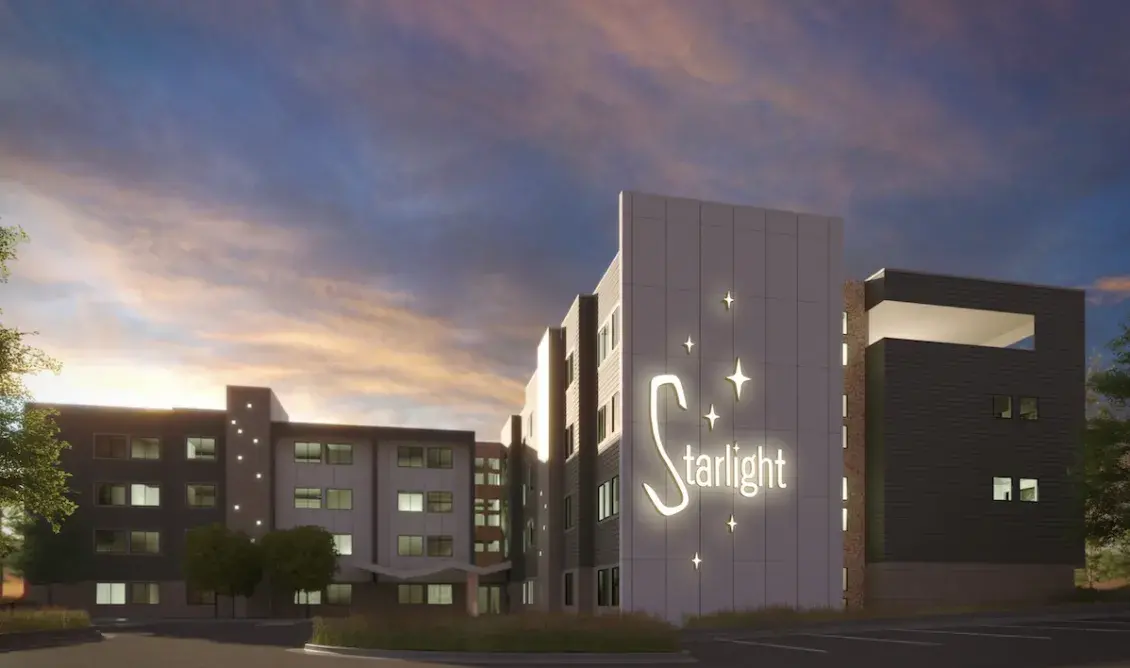The housing authority for the City of Littleton, Colorado, is embarking on its third development in as many years, thanks in part to the Denver Regional Transit-Oriented Development (TOD) Fund. A 73-unit, mixed-income community along the bustling West Littleton Boulevard corridor, Starlight Apartments will welcome residents in 2027, pending a Low-Income Housing Tax Credit award.
The loan to South Metro Housing Options (SMHO) is the latest investment from the TOD Fund, which launched in Denver more than 15 years ago and now serves the entire seven-county metro region. To date, the Fund has provided $72 million in below-market acquisition financing, helping quickly secure high-opportunity sites along transit corridors for affordable and mixed-income housing.
Managed by Enterprise’s Community Development Financial Institution (CDFI), the Enterprise Community Loan Fund, the TOD Fund is a partnership among state and local housing agencies, philanthropic institutions, CDFIs, and major banks. This marks the Fund’s third renewal for an additional five-year term – a testament to its success among funding partners and borrowers.
“The TOD Fund allows developers to acquire strategic sites near transit stops and allows for a longer hold period than a typical acquisition loan, all while offering a low, competitive rate,” Joseph Mattingly, senior loan officer, said. “The TOD Fund has helped developers acquire 29 sites since 2008, which has resulted in the preservation or creation of over 2,900 affordable homes for metro-Denver residents.”
Land Acquisition in a Tight Market
For SMHO, the TOD Fund provided a $1.2 million loan to purchase a vacant lot, which will become affordable apartment homes serving households earning 30- to 70-percent of the area median income. The flexibility of this financing also allowed the housing authority to negotiate with a neighboring family trust, ultimately assembling a larger site that expanded the project from 40–50 units to 73.
Land availability is one of the steepest barriers to affordable housing in Denver’s inner-ring suburbs. Littleton, a community of about 50,000 residents, offers few parcels suitable for development, which creates intense competition from market-rate buyers. This particular property was in high demand, since it is in a walkable, transit-rich corridor that the city is actively planning to revitalize.
“The TOD Fund allowed us to preserve our cash, compete for additional land, and move forward with a stronger, more ambitious project than we could have done otherwise,” said Sarah Buhr, SMHO’s real estate development manager.
The development has already secured commitments of $1.46 million from the State of Colorado, and $17 million in private activity bond cap, in addition to private equity. Local support has been strong, with Arapahoe County already committing over $580,000 to the project, and the City of Littleton has provided a letter of intent to provide up to $800,000 in funding.
Like many small housing authorities, SMHO historically focused on administering vouchers and public housing. But with limited federal reinvestment in public housing and rising local housing costs, the agency made the strategic decision to pursue development directly.
“Administering vouchers alone doesn’t cover costs,” Buhr explained. “Development is the way we can reinvest in the community and provide new housing opportunities.”
Deep Affordability in a 4% Deal
The Starlight Apartments demonstrates how income-averaging tax credits can stretch impact for residents. Properties can now meet affordability requirements if at least 40% of units average 60% of AMI or less, with unit designations set in 10% increments between 20% and 80%—expanding tax credit flexibility beyond the original 20 at 50 and 40 at 60 AMI tests.
Of the 73 homes:
- 11 will serve households at 30% AMI, far deeper than most 4% credit deals can support
- The balance of the units (62) will serve workforce households earning up to 70% AMI, with a mix of studios, one- and two-bedroom apartments
- SMHO will dedicate eight project-based vouchers to youth aging out of foster care, with supportive services provided through local partners.
“We’re proud of this model,” Buhr said. “Higher-income units help offset those deeply affordable rents, and in the end, everyone is just another resident of the community.”

A Modern Design Rooted in Place
The Starlight Apartments design incorporates mid-century modern elements, reflecting the style of the ‘Mid-Mod Mile’ along West Littleton Boulevard. SMHO designed the four-story, 73-unit community not only to fit the neighborhood’s character, but also to serve the people who keep it vibrant.
“The West Littleton Boulevard corridor is home to local businesses, retail, grocery stores, and transit options, which offers teachers, retail workers, and others the opportunity to live close to jobs and amenities,” Chase Seebohar, SMHO housing developer, said.
Since its inception, the Denver Regional TOD has helped create homes that keep people connected to their communities—developments like the Starlight Apartments show what’s possible.
“We have some great partners in the TOD Fund that have continued their investments for over 15 years,” Mattingly said. “With the renewal, we can continue to help developer partners acquire sites near transit to create and preserve more affordable units in the Denver-metro area for many years to come.”
TOD Fund partners include the Colorado Housing Finance Authority, the State Division of Housing, the City and County of Denver’s Department of Housing Stability (HOST), Mercy Community Capital, Impact Development Fund, Denver Foundation, Gates Family Foundation, Rose Community Foundation, First Bank, U.S. Bank, and Wells Fargo.

